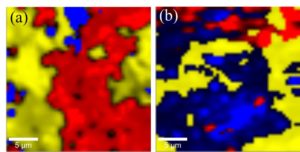Many traditional anti-corrosion approaches using chromate are effective but hazardous to the natural environment and human health, so development of sustainable and effective alternatives is desirable. Mussel adhesive proteins (MAP) derived from mussel byssus presents extraordinary adhesion to steel surfaces and exhibits film-forming and corrosion inhibition properties. Novel strategies for enhancing the corrosion inhibition of steel by composite films of MAP and ceria nanoparticles were recently developed. It was found that an increased time of exposure improves both corrosion protection and self-healing of films. We have used in-situ confocal Raman microscopy (CRM) to study the interaction between MAP and steel (iron), and DFT calculations to understand the binding between the functional group of MAP and ceria. The CRM spectra (Figure 1) revealed complex formation between MAP and iron.
References
Journal of Colloid and Interface Science 404 (2013) 62–71. DOI:10.1016/j.jcis.2013.05.016Electrochimica Acta 107 (2013) 276– 291. DOI: 10.1016/j.electacta.2013.05.078



